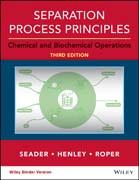
Separation Process Principles with Applications using Process Simulators
Seader, J. D.
Henley, Ernest J.
Roper, D. Keith
Separation Process Principles with Applications Using Process Simulator, 4th Edition is the most comprehensive and up–to–date treatment of the major separation operations in the chemical industry. The 4th edition focuses on using process simulators to design separation processes and prepares readers for professional practice. Completely rewritten to enhance clarity, this fourth edition provides engineers with a strong understanding of the field. With the help of an additional co–author, the text presents new information on bioseparations throughout the chapters. A new chapter on mechanical separations covers settling, filtration and centrifugation including mechanical separations in biotechnology and cell lysis. Boxes help highlight fundamental equations. Numerous new examples and exercises are integrated throughout as well. INDICE: About the Authors .Preface to the Fourth Edition .Nomenclature .Dimensions and Units .Chapter 1 Separation Processes .1.0 Instructional Objectives .1.1 Industrial Chemical Processes .1.2 Basic Separation Techniques .1.3 O Separations by Phase Creation .1.4 O Separations by Phase Addition .1.5 O Separations by Barrier .1.6 O Separations by External Field or Gradient .1.7 Brief Comparison of Common Separation Operations .1.8 Separation Processes, Product Purity, Component Recovery, and Separation Sequences .Summary References Study Questions Exercises .Chapter 2 Thermodynamics of Separation Operations .2.0 Instructional Objectives .2.1 Phase Equilibria .2.2 Ideal–Gas, Ideal–Liquid–Solution Model .2.3 O Graphical Representation of Thermodynamic Properties .2.4 O Nonideal Thermodynamic Property Models .2.5 O P–v–T Equation–of–State (EOS) Models .2.6 O Highly Nonideal Liquid Solutions .2.7 O Gibbs Excess Free Energy (gE) Models .2.8 O Predictive Models .2.9 O Electrolyte Solution Models .2.10 O Polymer Solution Models .2.11 Selecting an Appropriate Model .2.12 Exergy and Second–Law Analysis .Nomenclature Summary References Study Questions Exercises .Chapter 3 Mass Transfer and Diffusion .3.0 Instructional Objectives .3.1 Steady–State, Ordinary Molecular Diffusion .3.2 Diffusion Coefficients (Diffusivities) .3.3 Steady– and Unsteady–State Mass Transfer Through Stationary Media .3.4 Mass Transfer in Laminar Flow .3.5 Mass Transfer in Turbulent Flow .3.6 Models for Mass Transfer in Fluids with a Fluid Fluid Interface .3.7 Two–Film Theory and Overall Mass–Transfer Coefficients .Nomenclature .Summary .References .Study Questions .Exercises .Chapter 4 Single Equilibrium Stages and Flash Calculations .4.0 Instructional Objectives .4.1 Gibbs Phase Rule and Degrees of Freedom .4.2 Binary Vapor Liquid Systems at Equilibrium .4.3 Equilibrium Two–Phase Flash Calculations .4.4 Ternary Liquid Liquid Systems at Equilibrium .4.5 O Multicomponent Liquid Liquid Systems .4.6 Liquid Solid Systems .4.7 Gas Liquid Systems .4.8 Gas Solid Systems .4.9 Three–Phase Equilibrium Systems .Nomenclature .Summary .References .Study Questions .Exercises .Chapter 5 Multistage Cascades and Hybrid Systems .5.0 Instructional Objectives .5.1 Cascade Configurations .5.2 Single–Section, Liquid Liquid Extraction Cascades .5.3 Two–Section Distillation Cascades .5.4 O Membrane Cascades .5.5 O Hybrid Systems .5.6 Degrees of Freedom and Specifications for Cascades .Nomenclature .Summary .References .Study Questions .Exercises .Chapter 6 Absorption and Stripping .6.0 Instructional Objectives .6.1 O Equipment for Vapor–Liquid Separations .6.2 O General Design Considerations .6.3 Graphical Method for Trayed Towers .6.4 Kremser Group Method for Multicomponent Absorption and Stripping .6.5 Stage Efficiency and Column Height for Trayed Columns .6.6 Flooding, Column Diameter, and Tray Layout for Trayed Columns .6.7 Rate–Based Method for Packed Columns .6.8 Packed–Column Liquid Holdup, Diameter, Flooding, Pressure Drop, and Mass–Transfer Efficiency .6.9 Reactive (Chemical) Absorption .Nomenclature .Summary .References .Study Questions .Exercises .Chapter 7 Distillation of Binary Mixtures .7.0 Instructional Objectives .7.1 O Equipment and Design Considerations .7.2 McCabe Thiele Graphical Method for Trayed Towers .7.3 O Extensions of the McCabe–Thiele Method .7.4 Estimation of Tray Efficiency for Distillation .7.5 Column and Reflux Drum Diameters .7.6 Rate–Based Method for Packed Distillation Columns .Nomenclature .Summary .References .Study Questions .Exercises .Chapter 8 Liquid Liquid Extraction with Ternary Systems .8.0 Instructional Objectives .8.1 O Equipment for Liquid–Liquid Extraction .8.2 O General Design Considerations .8.3 Hunter Nash Graphical Equilibrium–Stage Method .8.4 O Theory and Scale–Up of Extractor Performance .Nomenclature .Summary .References .Study Questions .Exercises .Chapter 9 Approximate Methods for Multicomponent, Multistage Separations .9.0 Instructional Objectives .9.1 Fenske Underwood Gilliland (FUG) Method .9.2 Using the Shortcut (FUG) method with Process Simulators .Nomenclature .Summary .References .Study Questions .Exercises .Chapter 10 Equilibrium–Based Methods for Multicomponent Absorption, Stripping, Distillation, and Extraction .10.0 Instructional Objectives .10.1 Simple Model for a Vapor–Liquid Equilibrium Stage .10.2 Evolution of Methods for Solving the Mesh Equations .10.3 Strategies for Applying Process–Simulator Methods .10.4 Main Mathematical Procedures .10.5 Bubble–Point (BP) and Sum–Rates (SR) Methods .10.6 Simultaneous–Correction Method .10.7 Inside–Out Method .10.8 Rigorous Methods for Liquid–Liquid Extraction .Nomenclature .Summary .References .Study Questions .Exercises .Chapter 11 Enhanced Distillation and Supercritical Extraction .11.0 Instructional Objectives .11.1 Use of Triangular Graphs .11.2 Extractive Distillation .11.3 Salt Distillation .11.4 Pressure–Swing Distillation .11.5 Homogeneous Azeotropic Distillation .11.6 Heterogeneous Azeotropic Distillation .11.7 Reactive Distillation .11.8 Supercritical–Fluid Extraction .Nomenclature .Summary .References .Study Questions .Exercises .Chapter 12 Rate–Based Models for Vapor–Liquid Separation Operations .12.0 Instructional Objectives .12.1 Rate–Based Model .12.2 Thermodynamic Properties and Transport–Rate Expressions .12.3 Methods for Estimating Transport Coefficients and Interfacial Area 456 .12.4 Vapor and Liquid Flow Patterns .12.5 Method of Calculation .Nomenclature .Summary .References .Study Questions .Exercises .Chapter 13 Batch Distillation .13.0 Instructional Objectives .13.1 Differential Distillation .13.2 Binary Batch Rectification .13.3 Batch Stripping and Complex Batch Distillation .13.4 Effect of Liquid Holdup .13.5 Stage–by–Stage Methods for Batch Rectification .13.6 Intermediate–Cut Strategy .13.7 Optimal Control by Variation of Reflux Ratio .Nomenclature .Summary .References .Study Questions .Exercises .Chapter 14 Membrane Separations .14.0 Instructional Objectives .14.1 O Membrane Materials .14.2 O Membrane Modules .14.3 Mass Transfer in Membranes .14.4 Dialysis .14.5 O Electrodialysis .14.6 Reverse Osmosis .14.7 Gas Permeation .14.8 O Pervaporation .Nomenclature .Summary .References .Study Questions .Exercises .Chapter 15 Adsorption, Ion Exchange, and Chromatography .15.0 Instructional Objectives .15.1 Sorbents .15.2 Equilibrium Considerations .15.3 Kinetic and Transport Rate Considerations .15.4 O Equipment for Sorption Systems .15.5 Slurry and Fixed–Bed Adsorption Systems .15.6 Continuous, Countercurrent Adsorption Systems .15.7 O Ion–Exchange Cycle .15.8 Chromatographic Separations .Nomenclature .Summary .References .Study Questions .Exercises
- ISBN: 978-1-118-95074-6
- Editorial: John Wiley & Sons
- Encuadernacion: Rústica
- Páginas: 554
- Fecha Publicación: 18/01/2016
- Nº Volúmenes: 1
- Idioma: Inglés
